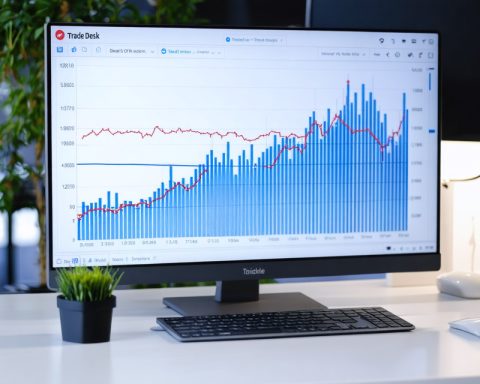- Artificial intelligence has been a major driver of growth for Wall Street, boosting indices like the Dow Jones, S&P 500, and Nasdaq.
- Former President Trump’s mention of imposing tariffs on semiconductor companies threatens to disrupt this AI-fueled progress.
- A proposed 25% tariff on technology giants could significantly impact companies like Taiwan Semiconductor and Nvidia.
- Such tariffs could strain global trade relations, especially in Asia, affecting international supply chains and partnerships.
- While AI promises transformative industry advancements, historical volatility in “next-big-thing” investments remains a concern.
- The future of AI growth may hinge on striking a balance between protectionist policies and the pursuit of innovation.
In a whirlwind era where Wall Street can’t help but dance to the rhythm of artificial intelligence, a mere sentence from former President Trump threatens to halt the exuberant tune. For over two years, AI has been the dazzling star propelling the Dow Jones, S&P 500, and Nasdaq toward uncharted heights, invigorating investors with promises of revolution and boundless potential.
Yet, when Trump hinted at imposing tariffs on semiconductor giants, the mood shifted. These aren’t just any tariffs; they’re significant enough to unsettle the fragile balance of the tech sphere. Picture a 25% levy on technology stalwarts and the ripple effects it would unleash across the globe. Taiwan Semiconductor, a linchpin in AI advancements, suddenly slows as tariffs escalate costs. Nvidia, perched at AI’s forefront, might find its climb to glory interrupted as its intricate ties with Taiwan Semi face strain.
Beyond economic entanglement lies a broader geopolitical impact. Tariffs threaten to erode crucial trade alliances in Asia, muddying waters already fraught with tension. While some American tech firms may find shelter, others, deeply woven into the international fabric, could face choppier seas.
Yet AI’s potential remains undisputed. The ability to empower systems with independent intelligence offers new frontiers for numerous industries. History, however, soundly reminds us of the volatility surrounding “next-big-thing” investments. The stage is set for a pivotal face-off between policy and progress; one that could determine whether AI’s journey remains unbroken or encounters a disrupting pause.
As the world watches, will the pressure of protectionism overpower the march of innovation, or will AI continue its meteoric ascent, defining the future at an unfettered pace? The answer hangs uncertain in the balance of global trade policy.
Will Tariffs on Semiconductors Disrupt AI’s Meteoric Rise?
How Tariffs Could Impact the Tech Sector
The announcement of potential tariffs on semiconductor imports introduces significant uncertainty into the tech industry, which heavily relies on these components. Here’s a breakdown of how such tariffs could impact the sector and broader economy:
Real-World Use Cases
1. Supply Chain Disruptions: Companies like Taiwan Semiconductor Manufacturing Company (TSMC) and Nvidia could see increased production costs, leading to higher prices for AI-related products and services. This could slow the deployment of AI in sectors like automotive, healthcare, and consumer electronics.
2. Investment Shifts: With increased costs, tech companies may divert investments from R&D to tariff-related expenses, potentially stunting innovation in AI technologies and reducing the pace of advancements.
3. Global Trade Dynamics: Tariffs could exacerbate existing tensions in U.S.-Asia trade relations. Countries heavily invested in semiconductor production, such as South Korea and Japan, might retaliate or redirect their supply chains, causing a realignment in global tech alliances.
Market Forecasts & Industry Trends
The imposition of tariffs may initially depress semiconductor market growth. However, long-term forecasts suggest AI demand will continue to drive sector expansion, potentially at a slower pace. According to Gartner, the AI market is predicted to reach $500 billion by 2024, fueled by applications across industries from fintech to telemedicine.
Features, Specs & Pricing
With tariffs, expect increased prices on AI-equipped consumer electronics, from smartphones to IoT devices. Enterprises may face higher costs for cloud computing services as data centers absorb tariff impacts on hardware.
Security & Sustainability
Rising costs could push manufacturers toward more sustainable practices, such as localizing supply chains to reduce dependency on tariffs-affected markets. There might be a shift to alternative semiconductor sources or materials, emphasizing energy-efficient and environmentally-friendly practices.
Insights & Predictions
Experts predict that while tariffs could temporarily disrupt AI integration, foundational demand for AI technologies will continue to grow. Strategic adjustments, like diversifying supply chains or investing in domestic chip manufacturing, could mitigate long-term effects.
Pros & Cons Overview
Pros:
– Potential to boost domestic semiconductor production.
– Encouragement for tech sector to reduce dependency on volatile trade regions.
Cons:
– Increased costs for consumers and businesses.
– Potential slowdowns in AI innovation and deployment.
– Intensified geopolitical tensions and trade wars.
Actionable Recommendations
1. Diversify Suppliers: Companies should explore alternative supply chains to minimize tariff impacts, including partnerships with emerging semiconductor businesses outside U.S.-China trade routes.
2. Invest in Domestic Production: U.S. tech firms should consider investing in local manufacturing facilities to reduce import dependencies and capitalize on potential government incentives.
3. Focus on R&D: Continuous investment in AI research and development will help firms maintain innovation momentum, essential for long-term success against competitive pressures.
4. Monitor Policy Changes: Stay informed about international trade developments and potential shifts in tariff policies to make timely strategic business decisions.
For more information on developments in global trade and technology sectors, visit CNBC or Bloomberg.









